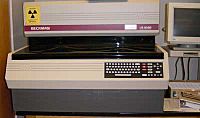Liquid scintillation counting facts for kids
Liquid scintillation counting is an analytical technique. It is used to measure radiation from beta (alpha) - emitting nuclides. It can also detect the auger electrons emitted from Chromium-51 (51Cr) and Iodine-125 (125I) samples. Samples of nuclides are dissolved or suspended in a "cocktail". The "cocktail" is containing an aromatic solvent and small amounts of other additives known as fluors. Beta (alpha) particles emitted from the sample transfer energy to the solvent molecules. The molecules in turn transfer their energy to the fluors. The excited fluor molecules dissipate the energy by emitting light. Scintillation cocktails often contain additives that shift the wavelength of the emitted light. It makes it more easily detected.
The samples are placed in small transparent (often glass or plastic) vials. They are loaded into a liquid scintillation counter. The counter has two photomultiplier tubes. They are connected in a coincidence circuit. The coincidence circuit assures that genuine light pulses are counted. Counting efficiencies under ideal conditions is about 30% for tritium. Tritium is a low-energy beta emitter. It is nearly 100% for phosphorus-32 (32P). Phosphorus is a high-energy beta emitter. Some chemical compounds and highly colored samples can interfere with the counting process. This interference is known as "quenching". It can be overcome through data correction or through careful sample preparation. 32P can also be counted in a scintillation counter without the cocktail. This technique is known as Cherenkov counting. It relies on the Cherenkov radiation being detected directly by the photomultiplier tubes. Cherenkov counting in this experimental context is normally used for quick rough measurements.


